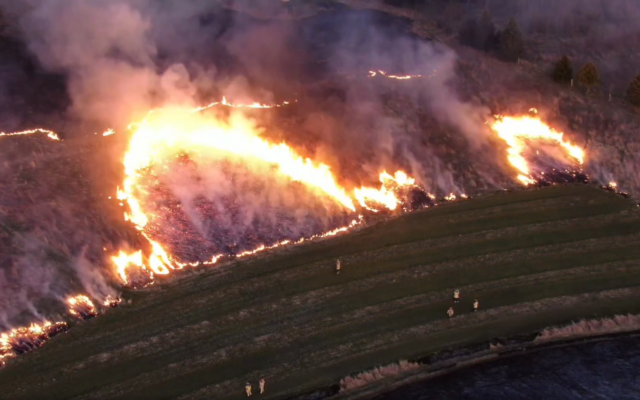How the White House could be more green

▶ Watch Video: Biden says climate change presents “opportunity” to create green jobs
To create jobs and make the economy less dependent on fossil fuels, President Joe Biden’s $3 trillion infrastructure plan aims to fortify buildings across the country, making them more energy efficient. Installing renewable energy sources, removing noxious materials and improving water efficiency in buildings on a mass scale can reduce dependence on fossil fuel energy, which in turn would lessen the threat of a climate crisis.
The White House, more than 200 years old, could be one place to start.
“If you can plan an infrastructure for the United States, you can plan a deep retrofit for the White House,” said Scot Horst, founder of Arc Skoru, a firm that works with companies looking to improve their environmental impact.
Low-flush toilets and upgraded insulation were installed in the George W. Bush administration. According to the Department of Energy, the portico lantern was outfitted with LEDs in 2008.
Lighting is a typical place to start efforts to make a building green, according to Horst.
“You start by thinking about lights. You say, ‘I think we can do a lighting retrofit.’ But in order to be thinking about the lighting retrofit, you need to be thinking about natural daylight,” he said. “And because it’s not just about changing the bulbs — it’s about using less energy when you possibly can — that means you also need to look at the color of the paint on the walls, because that’s about the reflectivity of the light that’s bouncing around that you’re using.”
Horst, who previously oversaw the Leadership in Energy and Environmental Design certification program at the U.S. Green Building Council, told CBS News that the White House could “easily” obtain platinum LEED certification, the highest rating possible. LEED projects earn scores on various green architectural qualities. The group says more than 90% of their new construction projects improve a building’s energy efficiency by “at least” 10%.
Achieving LEED certification was a goal of the Obama administration in 2009, but that effort never materialized.
The White House, with its constant traffic and security concerns, would make construction complicated. The residence is six stories with 147 windows, 132 rooms, 35 bathrooms, 28 fireplaces, eight staircases and three elevators. The West Wing is a working office seven days a week. Further complicating the process, numerous federal agencies would have to work together on a potential renovation project.
The most recent White House renovation took place over 17 days in 2017 and took 200 laborers. President Donald Trump moved temporarily to his New Jersey golf club while paint was refreshed, carpet was installed and the HVAC system, installed in 1990, was replaced.
“Due to the 24/7, 365-day use a year, the estimated age of the system based off of usage is 81 years old,” then-deputy press secretary Lindsay Walters said at the time. Making the building more energy efficient was not a stated goal of the project.
A large-scale effort to renovate the White House would require the assembly of a large team, said Gardiner Hallock, Monticello’s vice president of architecture, collections and facilities.
Hallock said major renovations on historic buildings require architects, engineers, historians, architectural conservators, and more.
“You need all those perspectives to have a successful project and at the White House I’m sure it’s times 10 just given the complexity of the building.”
Horst said the most direct way to make the White House more efficient is to look at how energy is getting to the building. Carbon neutrality is Mr. Biden’s 2050 goal for the country. Horst said it’s possible at the White House as well.
Renewable energy at the White House has been inconsistent. President Jimmy Carter installed solar panels on the White House roof in 1979. President Ronald Regan removed them. President George W. Bush installed panels on a maintenance structure in 2003 and President Barack Obama put panels back on the White House roof in 2010.
CBS News asked the National Park Service, the General Services Administration and the Department of Energy from where White House energy is currently supplied. They all deferred to the White House, which declined to comment.
Internally, the retrofitting process would be more complex if the building contains hazardous materials. Horst said the White House’s history of smaller renovations throughout the years might mean trouble for construction, as “trendy” products could have been used in the past that are now known to be toxic.
He believes Mr. Biden should push the White House to become water neutral, meaning no water on the property is wasted. This can be done by installing a “very cost efficient” greywater irrigation system, which captures rain and wastewater from the building, filters it, and reuses it.
CBS News reached out to the White House to see if there are any current plans to make the building more energy efficient. An administration official said they have multiple projects in the conception phase but are not yet ready to announce anything.
There are smaller measures that could be implemented to make the building more green. Experts told CBS News that the White House could ban bottled water to lower plastic use, install a compost system to lower landfill waste and fertilize the landscaping. More ceiling fans would circulate cooler air, making temperatures less reliant on HVAC.
Ultimately, Horst said, Mr. Biden should learn from the past. He pointed to President Bill Clinton’s Council on Sustainable Development which worked to make the White House more efficient, but failed to spur national change.
“How they see the world is going to impact how they address that building, but how they also address carbon emissions totally and the issues we face of the day. It’s not really about scoring points, or becoming well known because you redid the White House,” said Horst. “It’s about really addressing the world.”



